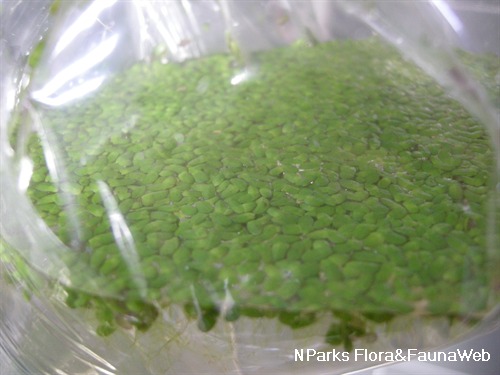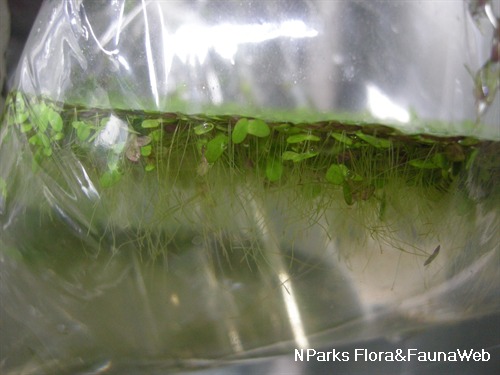
Name
Classifications and Characteristics
| Plant Division | Angiosperms (Flowering Seed Plants) |
|---|---|
| Plant Growth Form | Aquatic & Hydrophyte (Floating Aquatic) |
| Lifespan (in Singapore) | Perennial |
| Mode of Nutrition | Autotrophic |
Biogeography
| Native Distribution | Cosmopolitian |
|---|---|
| Native Habitat | Aquatic (Freshwater Pond / Lake / River) |
Description and Ethnobotany
| Growth Form | Has a prostrate growth form and grows in all directions on the water surface. |
|---|---|
| Roots | The roots of Lemna minor are solitary, one root to a thallus and are un-branched. |
| Foliage | The leaves and stems of Lemna minor are fused together to form a green coloured structure called a 'thallus'. The thallus is flattened, ovate to oblong in shape and has a smooth upper surface and has air spaces within, enabling it to float on water. Each thallus has three veins. |
| Flowers | Inconspicuous and white, the flowers are uncommon. |
| Fruit | Fruits are uncommon. |
| Habitat | Is found growing in water bodies with still or slow-moving water. It grows rapidly in waters with high nutrient values and may even cover the entire surface of small water bodies. |
| Cultivation | Can tolerate pH values between 5.0 to 9.0 but grows best in pH values of 6.5 to 7.5. It grows under full sun or partial sun in still water and grows slowly in water with low nutrient levels but grows rapidly via budding when in water with high nutrient levels. |
| Ethnobotanical Uses | Agriculture - Forestry: It is used as animal feed for domesticated animals such as fishes, ducks and pigs as it has high nutritive value especially protein. The practice of its usage as animal feed is commonly practised in Vietnam and Taiwan. |
Landscaping Features
| Landscape Uses | Phytoremediation (Ground / Water Contaminant(s)) |
|---|---|
| Usage Hazard - Cons | Invasive / Potentially Invasive |
Plant Care and Propagation
| Light Preference | Full Sun, Semi-Shade |
|---|---|
| Water Preference | Lots of Water |
| Plant Growth Rate | Fast |
| Rootzone Tolerance | Waterlogged Soils (Does not Drain Site), Easy to Grow |
| Maintenance Requirements | Low |
| Fertilizing | Fertilizers should not be added as addition of fertilizers into the water can lead to rapid growth, which may result in the plant becoming invasive. |
| Potential Problems | It may spread rapidly over the water surface and block off light to submersed plant, killing them off. |
| Propagation Method | Seed, Division |
| Propagation Ease | Easy |
| Plant Growth Rate Remarks | It can grow rapidly in waters with high nutrient content. In cases of over-population, the plants may be manually removed by skimming nets over the water surface. |
| Propagation Method Remarks | The plant propagates itself mainly by spontaneous division or budding where daughter plants grow from margins of the mother plant. |
Image Repository
Others
| Master ID | 31289 |
|---|---|
| Species ID | 5686 |
| Flora Disclaimer | The information in this website has been compiled from reliable sources, such as reference works on medicinal plants. It is not a substitute for medical advice or treatment and NParks does not purport to provide any medical advice. Readers should always consult his/her physician before using or consuming a plant for medicinal purposes. |

